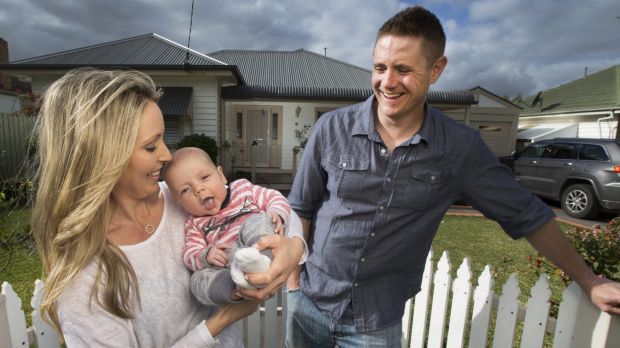
Sarah and James Leury with their three-month-old son Jack. Photo: Simon O’Dwyer
Sarah Leury gave birth to a perfect baby boy three months ago, but her tears from the grief she endured in arriving at that moment are still close to the surface.
She went through 12 cycles of IVF over a period of five years before becoming pregnant for the first time, spending nearly $100,000 in the process.
“Units with very low results should be given a lift … or close down.”
Robert Woolcott
“It’s still very raw now even to talk about it,” she said.
“But we were just so determined to have a family and I just knew I was destined to be a mum and I wasn’t going to give up.”
She now attributes the birth of Jack to her decision to change clinics after 10 cycles at the one recommended by her GP.
When the first clinic started talking about donor eggs, she decided to seek help elsewhere, and became pregnant on her second cycle at Monash IVF, which claims to have one of the highest live birth rates in Australia.
The original IVF clinic did not advertise its success rate and there was no other way to tell.
Couples with fertility problems have little way of knowing which IVF clinics are the best performers despite vast differences between their success rates, because the principal body for reproductive medicine refuses to publish the live birth rates.
But a new web-based tool that predicts patients’ likelihood of delivering a live baby may allow consumers to compare their chances at different clinics.
The latest Australian and New Zealand Assisted Reproductive Database (ANZARD) shows the live delivery rate from 40,000 fresh IVF treatments in 2011 ranged from 4 per cent at some clinics to 30.9 per cent at others.
Each clinic is told where it sits in the percentile rankings, but the full results are not provided to the clinics, patients, Medicare or private health insurers.
The Society for Assisted Reproductive Technology in the United States has set up a web tool that allows patients to enter their vital details into an algorithm and predict their chances of bringing home a baby at any given IVF clinic.
The Fertility Society of Australia (FSA), which represents IVF clinics, wants to roll out an Australian version of the tool later this year – if the clinics agree.
FSA vice-president Michael Chapman said it would initially give patients an average across all clinics but ideally allow them to search individual clinics in the future.
“That’s the direction we’re heading,” Professor Chapman said.
“We should be more transparent.”
Fertility specialists have been bitterly divided over how and whether to publish live birth outcomes, with fertility specialists at the better performing clinics lobbying for transparency and the FSA officially opposed to the data being released.
Monash IVF director Richard Henshaw, whose clinic is in the top 25 per cent for live birth outcomes, has accused the FSA of working against the interests of patients to protect its worst performing members.
But FSA president Mark Bowman’s own clinic, Genea?, has been reported to the government regulator for favourably comparing his clinic to others, claiming on its website to have a 40 per cent greater chance of taking home a baby than other clinics.
This prompted the FSA to issue a bulletin to its members this month warning them not to use the ANZARD data to “make statements of a comparative nature” in public information and advertising.
Professor Chapman said clinics should not use the ANZARD data to make marketing claims because it did not enable like comparisons to be made.
Some clinics had an older age profile or other variables that affected their outcomes, he said.
“The data, as it is collected at the moment, is not comparing apples with apples,” Professor Chapman said.
Genea director Robert Woolcott? said the government regulator had not proceeded with the complaint against his clinic and that it stood by its right to compare itself to the industry average.
“Comparisons to all other clinics are entirely valid and that data should be made available to the public,” Dr Woolcott said.
“Units with very low results should be given a lift, take mentoring from other clinics or close down.”
But he said league tables were not in the public interest as they may encourage more poorly performing clinics to increase the number of embryos transferred or push patients with minor infertility problems into treatment they did not need.
Patient advocacy group AccessAustralia opposes the publication of data.
AccessA president Sandra Dill said some patients may want to try a treatment that has a statistically less favourable outcome, such as ovulation induction, which is not offered at all clinics.
“This may have a favourable outcome. If not, it can at least empower patients knowing they have explored all the options,” Ms Dill said.
But Adelaide woman Jo Miller said she would have liked more information on outcomes before attempting IVF.
She chose an IVF clinic that was closest to her home since the referring doctor said they were all the same.
She did three cycles at the first, cheaper IVF clinic before switching clinics and falling pregnant with Zara, now five months old.
Her new fertility specialist quickly ascertained that she had an easily treated fertility problem.
“There’s not a lot of information for consumers at all,” Ms Miller said.
“Cost for us wasn’t a huge factor but I did three cycles at [the first place] that I now consider a waste of money.
“If I could have compared places it would have made my choice [of] where to go easier.”
Dr Woolcott said it was neither in the interests of patients, nor clinicians nor the government to spend money on procedures with a small chance of success.
“What do you think matters to a patient with fertility problems?” Dr Woolcott said.
“It’s a live, healthy baby
